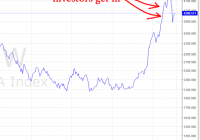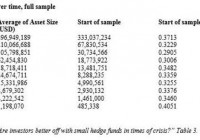
Summary Why you should always be thinking about protecting your assets. Why holding cash is always a good idea. What you can learn from history and China about playing defense for maximum wealth generation. Ouch. That’s how I felt in 2008 when my portfolio was down 28.6%. The S&P was down 37% that year but I certainly didn’t care about having beaten the market. I’m supposed to be indifferent to how the market is doing and to take a long term focus. After all, that’s what I tell people all the time. But I remember it clearly. I was in Seoul, Korea getting married while the market was crashing. Obviously, I wasn’t concerned because I was sweating bullets while waiting at the altar. Also, being on the other side of the world helps drown out the noise. Then it was straight to the honeymoon and by the time I woke up, the market was in ashes. I was excited though and I had to sneak away to the resort lobby and hurriedly put in some trades before my newlywed wife noticed that I was missing. But despite all that, when 2008 came to an end, my portfolio was hurting by 28.6%. It wasn’t hurt from losing money. The hurt was due to the wasted opportunities I couldn’t take advantage of because I was 100% invested. The Current Situation At the moment, I have 20% in cash which provides flexibility and the opportunity to act if needed. Here’s what Prem Watsa, “Canada’s Warren Buffett”, once said during a conference call about having a high cash position. As far as the 30% cash, remember, that can change. So in 2008, and we had this position in 2007, in 2006. 2008, things turned the financial markets. Stock markets dropped… about 50%… And Tom, the only people who could benefit from that were the people who had cash or government bonds. And so we are conscious of that in our history. Cash gives you options, gives you the ability to take advantage of opportunity but you have to be long-term. We have built our company with a long-term view. Our long-term results are excellent. For example, in 2007, ’08, and ’09, the 3 years, 2007, 2008, 2009, we made $2.8 billion after tax, our book value went up by 150%. Since that time, we haven’t done a lot. But we’ve said to our shareholders that we are long-term focused, our results are lumpy and we never know when it can change. But the cash gives us a huge advantage in terms of taking advantage of opportunity as and when they come. It’s not just in the stock market. People who had the cash to scoop up cheap real estate, businesses or even liquidated inventory to flip have all done well while other people were running scared. Warren Buffett says something similar. We always keep enough cash around so I feel very comfortable and don’t worry about sleeping at night. But it’s not because I like cash as an investment. Cash is a bad investment over time. But you always want to have enough so that nobody else can determine your future essentially. So are you 100% invested or do you have some room to take advantage of opportunities if it comes up? Are you willing to sacrifice 1-2% in potential returns by holding cash, or are you trying to squeeze out every basis point possible without considering what could happen? Cash Does Nothing and Is a Bad Investment True. If you’re talking about a long term horizon greater than 10 years, that is. Holding cash isn’t a popular choice because you feel like you are missing out on opportunities while everyone else is making money . Instead of holding cash, financial commentators prefer to recommend defensive companies, even after the stock market plummets when fear is supreme. But that’s the worst time to be buying defensive stocks anyways because everyone else is thinking the same thing. Plus, it assumes you have the cash to buy defensive stocks to begin with. If cash isn’t your thing, then the next best thing would be rebalance your portfolio from speculative growth picks to recession proof businesses and sleep well at night. Ditto. Learn from History and the Current Chinese Market In Howard Marks memo titled “Ditto”, there’s a section that outlines the cycle in attitude towards risk. 1. When economic growth is slow or negative and markets are weak, most people worry about losing money and disregard the risk of missing opportunities. Only a few stouthearted contrarians are capable of imaging that improvement is possible. 2. Then the economy shows some signs of life, and corporate earnings begin to move up rather than down. 3. Sooner or later , economic growth takes hold visibly and earnings show surprising gains. 4. This excess of reality over expectations causes security prices to start moving up. 5. Because of those gains – along with the improving economic and corporate news – the average investor realizes that improvement is actually underway. Confidence rises. Investors feel richer and smarter, forget their prior bad experience, and extrapolate the recent progress. 6. Skepticism and caution abate; optimism and aggressiveness take their place. 7. Anyone who’s been sitting out the dance experiences the pain of watching from the sidelines as assets appreciate. The bystanders feel regret and are gradually suckered in. 8. The longer this process goes on, the more enthusiasm for investments rises and resistance subsides. People worry less about losing money and more about missing opportunities. 9. Risk aversion evaporates and invests behave more aggressively. People begin to have difficulty imagining how losses could ever occur. When you look at how Howard Marks explains this cycle, it’s clear that history may not repeat, but it does rhyme. And it’s currently rhyming in China. (click to enlarge) My mother-in-law theory is that when my mother-in-law wants to get into the stock market or starts to recommend stocks as an investment, it’s time to move to cash. That’s what happening in China though. But look to history. (click to enlarge) The US market is different to the Chinese market, but it’s a lesson nonetheless and something to keep at the back of your mind. How Far Will the Market Continue Going Up? I consider myself an optimistic person and many times, it has worked against me. A lot of the times, I don’t want to think about the bad things that could happen and I end up pushing it under the bed. And this market isn’t easy to invest in. Most hedge funds aren’t even in positive territory after fees this year. But will the market continue to go up forever? Don’t think so. There has to be a crash correction. My way of playing defense is to be alert and not contempt. I don’t trust or listen to market news or forecasters because they are just as clueless as me about what the market will do next. All I can say about forecasters and market predictions is to quote the following. There are two kinds of forecasters: those who don’t know, and those who don’t know they don’t know. – John Kenneth Galbraith How Do I Play Defense? Here’s how I do it. I’ve printed out Seth Klarman’s thoughts on holding cash and read it regularly or whenever I feel like I’m missing out. Read Howard Marks memos, Buffett letters and other papers and book on behavioral finance. I highly recommend What I Learned Losing a Million Dollars . It’s one of those books that make you grow. But reading books outside of investing keeps me fresh and always provides new insight on how I can improve. I don’t talk about stocks with non value investing people, which means I never talk about stocks at all in day to day life. Maintain a buy list. Remind myself to stop overpaying because valuation matters more than ever . There is a time for offense, but right now, I’m playing more defense. Offense wins games, but defense wins championships. So where are you at the moment? Offense or defense? Disclosure: I/we have no positions in any stocks mentioned, and no plans to initiate any positions within the next 72 hours. (More…) I wrote this article myself, and it expresses my own opinions. I am not receiving compensation for it. I have no business relationship with any company whose stock is mentioned in this article.

